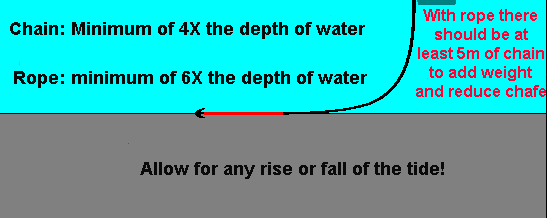Preparation
Before you decide where to anchor there are a few considerations to take in to account.
- Changes in depth: When you anchor in an area with a rise and fall of tide, it is essential that you know that there will be sufficient depth for the vessel at low tide.
This is ensured by calculating the height of tide when you arrive, subtracting the height of low water to find the fall of the tide, then adding this to the draught of the boat and the required clearance below the keel at low water. See the example below:
Height of tide on arrival = - Height of low tide = Fall of the tide = + Draught of vessel = + Clearance required below the keel at low water = Minimum depth of water in which to anchor = |
5.0m 1.5m 3.5m 1.4m 1.0m 5.9m |
This has been called the FUD rule. This stands for FALL+UNDER+DRAUGHT.
The yacht then motors around the area, surveying the depths with the echo-sounder and the skipper selects a spot where the depth of water is 5.9m or more. Obviously, the chart can be consulted first to find an area where the depths are likely to be suitable for anchoring, but the final spot is chosen by the above method (when checking the depth, remember to allow for the swing of the boat).
- Boat preparation: The foredeck should be prepared by;
|
- Depth: Is the water shallow enough for the length of cable carried? Is it deep enough for the boat, now and later? How much cable should be laid out?

Anchors work best when pulled horizontally. This is only ensured when there is sufficient scope or length of cable laid, if insufficient cable is laid out, it is likely that the anchor will drag.
Sailtrain.co.uk is free to use, but if you feel you would like to contribute to the running and development costs you can donate via Paypal:
Additional Resources:

